Lisa Gray writes about a guy who thinks Houston’s streets could be much more user friendly if only we tried a little harder to make them be.
“Houston’s streets behave like alleys,” Nathan Norris shouted to the 20 or so people who followed him like ducklings, single file, on Jackson Hill Street’s skinny sidewalk.
Norris is a professional urban scold, a consultant for the town-planning firm Placemakers, who travels the country telling developers, neighborhood groups and cities what they can do to improve their street life.
He gestured, disgusted, at what he saw on Jackson Hill — a prosperous-looking residential street. It’s part of fast-growing Super Neighborhood 22, the area around Washington Avenue’s clubs and restaurants.
But Jackson Hill is not a street where you want to linger.
[…]
“I have traveled far and wide, and I have never run across a city that has as much unmet potential as Houston,” Norris wrote. “And the funny thing is that it would take such a minor change for Houston to reach its potential.
“Imagine New York, Chicago or L.A. trying to undo its business-unfriendly culture. That is not going to happen anytime soon. Dallas and Austin are not going to grow a port.
“But Houston could simply tweak some minor functional design regulations, and the developers would start building beautiful places that could provide Houston a vibrancy and hipness that would attract the next generation of leading professionals.”
I like what he’s saying, but I have two simple questions: What exactly are the simple tweaks that need to be done to make Houston’s streets better? And how do they affect existing streets where there’s unlikely to be much new housing construction?
Documenting the problem is easy enough, and Gray quotes Norris at length: Skinny sidewalks (where they exist at all), lack of trees, and utility pole obstruction. I figure a picture is worth a thousand words, so here are a few I snapped on Jackson Hill the other day.
That’s a block south of Washington at the corner of Jackson Hill and Lilian Street; a parking lot for Patrenella’s is right behind where I’m standing. Talk about useless – anyone walking this way will have to take the street, which could be dangerous that close to a busy road like Washington. There were plenty of other examples, all on the same (east) side of the street, or utility poles getting in the way.
I guess utility poles have to go somewhere, but is this the middle of the sidewalk really the best place for them?
At least on the corners there are some limited options for working around the problem.
These metal poles were incredibly tall, much taller than any of the houses in the area. I guess they kind of hide their ugly mess of wires by being too high up for most people to notice, but they sure do take up a lot of space.
Go ahead, get past that on the sidewalk. I double dog dare you.
The solution to this problem is obvious enough: Bury the utility lines so you can lose the poles. Bingo, you get better sidewalks, more room for trees (whose branches won’t need to be trimmed to avoid interfering with utility wires), and no blackouts due to downed power lines during nasty storms. Remember how some parts of town didn’t lose power during Hurricane Ike? What they all had in common was buried power lines.
How to pay for all that is another question, but at least we know what to do. The problem is that at least in this area, Jackson Hill is an exception. It has sidewalks and curbs (no drainage ditches), and is wide enough to accommodate street parking without making the street impassable when two cars approach from opposite directions. Compare Jackson Hill to Snover Street, two blocks west:
You can actually envision Jackson Hill as a better, more pedestrian-friendly street, once you remove the poles and widen the sidewalks. There’s room to do all that and not make the streets a choke point. Can you do the same here?
That’s Snover Street, which is narrower, has a sidewalk on only one side, has no curbs, and has a drainage ditch. Filling in the drainage ditch and installing another sidewalk with curbs on each side of the street would help, but it’s not clear you want to encourage street parking on this narrow roadway. And a lot of the other streets in the area are worse. Try navigating Malone, where the Beer Can House is, for example. How do you deal with streets that are too narrow to accommodate the addition of sidewalks?
That’s the crux of my question. How do you retrofit these ideas into existing neighborhoods? If we were to tear Houston down and rebuild it all from scratch, it would be easy to install better streets. What do we do with what we’ve got? How practical is it, and how expensive? I’m all in favor of adopting better standards for new development – there’s certainly no reason to keep making the same mistakes if we don’t have to – but we should recognize the limited extent to which that would transform Houston. Even when that new development takes place in the existing urban core where you’d really like to have it, the positive effect will be mitigated as soon as it runs into a typically pedestrian-unfriendly bordering development. Still better than nothing, but color me less optimistic than Nathan Norris.
Anyway. I haven’t spent any time researching this myself, and maybe if I’d attended Norris’ presentation he’d have answered all of my annoying questions. I didn’t really expect an answer in an 800-word article. But these are the things I think about when I hear someone talk about transforming Houston’s streets, and they’re the things that I think about when I start daydreaming about a more robust light rail network. I hope someone has better answers to these problems than I do.

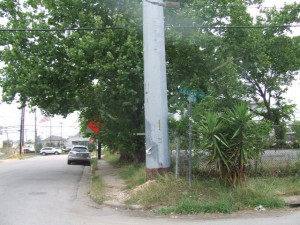
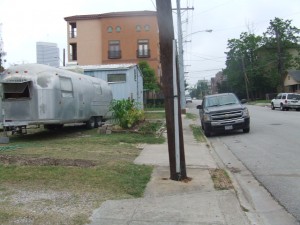
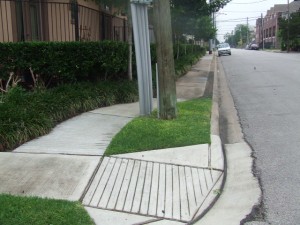
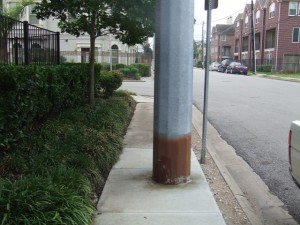

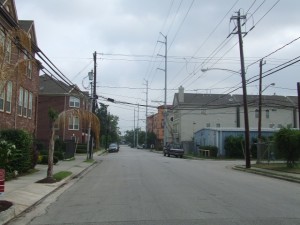

Oh yeah, he’ll tell you how to do it – for a substantial consulting fee.
I agree with Norris’ general principle that Houston streets can and must better balance the needs of motorists with those of pedestrians and cyclists. That said, you’re right that it may be difficult to implement Complete Streets on many Houston residential streets because of the narrow right-of-way.
Here’s part of the problem: the City of Houston currently has a one-size-fits-all roadway design standard that is geared towards greenfield construction of new roadways in suburban areas. It calls for 12-foot minimum vehicle lanes, minimal 4-foot sidewalks, and sweeping curb radii at intersections to make sure that even semi-trailers can take corners quickly. That may be appropriate if you’re building a new FM-1960; but it’s a horrible recipe if you’re reconstructing a 100-year-old neighborhood street.
Now consider that the voter-approved, drainage fee-funded Rebuild Houston effort intends to enable reconstruction of a LOT of Houston streets during the next decade. Applying Houston’s current suburban street standards to the streets you identified above will make them worse for residents, pedestrians, and cyclists, rather than better.
Hundreds of US cities — including Dallas (ahead of us again) — are adopting Complete Streets standards that take a context-sensitive approach to roadway design, recognizing that different streets serve different purposes in our communities. While some streets can be for moving large volumes of large vehicles, many of our neighborhood streets will function better when we design them to allow pedestrians and cyclists to come/go safely from schools, shops, restaurants, etc.
Complete Street designs dramatically improve safety for all users, and Houston could use some of that. Right now, Houston is the 8th deadliest US city for motorists killing pedestrians and cyclists. Even better, Complete Street designs improve both retail sales and property values. A small investment in better street design will pay large dividends.
If you agree that Houston needs a Complete Streets policy, consider signing Houston Tomorrow’s petition for Complete Streets at http://petition.houstontomorrow.org. Thanks!
Robin Holzer, board chair
Citizens’ Transportation Coalition (CTC)
http://ctchouston.org
http://facebook.com/ctchouston
Answering the questions raised:
1. I actually spent 3 days in Houston in exchange for expenses. Approximately two days were devoted to touring within the Loop, and one day was dedicated to providing a day long series of presentations on how and why Houston should update its rules that govern development. I did it because I am convinced that Houston really does have the most potential of any city in the U.S. (at least inside the Loop)—- the only question is whether Houston has the political will to make it happen. Once Houstonians realize how much they have to gain (as well as the developers), I think it will happen.
2. Context is the key to neighborhood design. As Robin referenced, one of Houston’s problems is that it does not permit context to drive the design of its thoroughfares. Without greater flexibility, Houston will continue to underperform.
3. The key details that must change are the boring functional design details that matter: (1) thoroughfare design; (2) public frontage design; and (3) private frontage design. These items translate into issues such as lane width, number of lanes, parking type, parking lane width, planting strip width, tree/canopy types, tree spacing, lighting type, public furniture, walkway width, setbacks, first layer fenestration, building lot occupation, parking location, driveway width, building type, etc. These details work in unison— so they have to be mutually reinforcing. They also need to be appropriate to the context. A heavily traveled street has completely different details than a low-volume street.
4. I do not recommend that you change everything, everywhere, all at once. I recommended a phased approach that would focus on specific corridors.
5. I hope to return in June, and I anticipate that we will conduct another public workshop that explains these details in greater detail. It would be great to see you there!